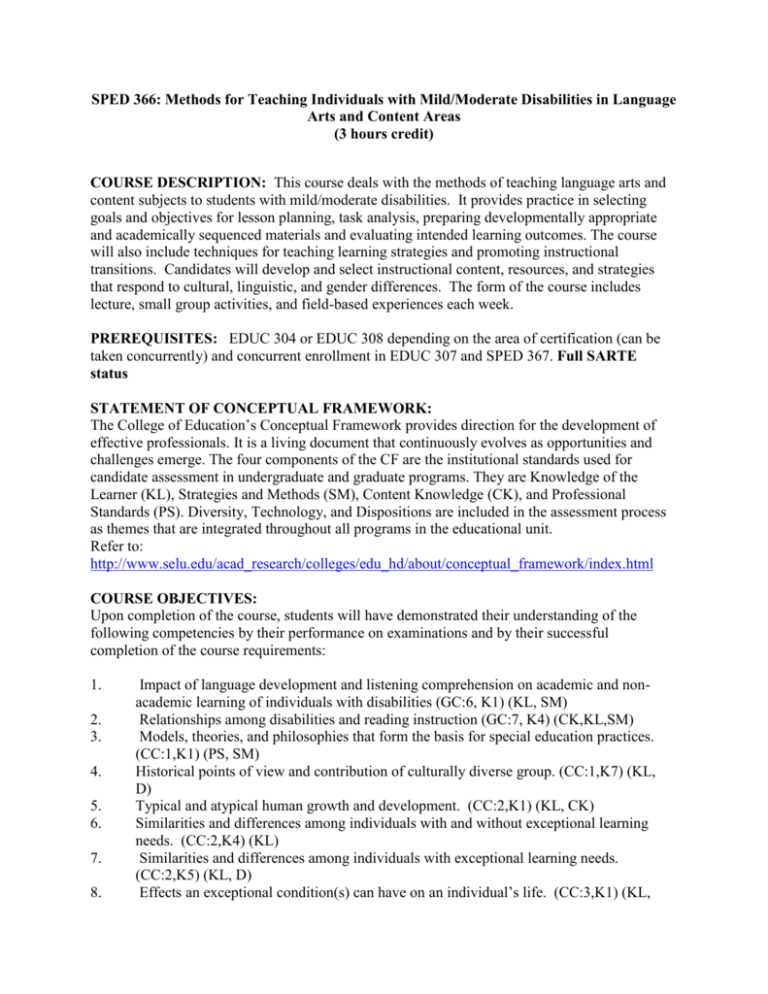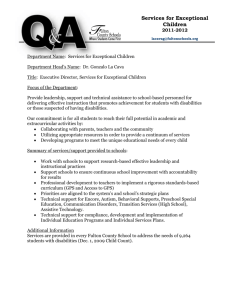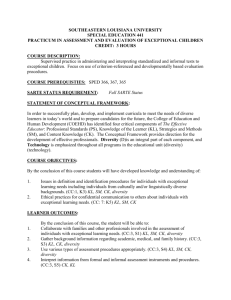SPED 366: Methods for Teaching Individuals with Mild/Moderate
advertisement

SPED 366: Methods for Teaching Individuals with Mild/Moderate Disabilities in Language Arts and Content Areas (3 hours credit) COURSE DESCRIPTION: This course deals with the methods of teaching language arts and content subjects to students with mild/moderate disabilities. It provides practice in selecting goals and objectives for lesson planning, task analysis, preparing developmentally appropriate and academically sequenced materials and evaluating intended learning outcomes. The course will also include techniques for teaching learning strategies and promoting instructional transitions. Candidates will develop and select instructional content, resources, and strategies that respond to cultural, linguistic, and gender differences. The form of the course includes lecture, small group activities, and field-based experiences each week. PREREQUISITES: EDUC 304 or EDUC 308 depending on the area of certification (can be taken concurrently) and concurrent enrollment in EDUC 307 and SPED 367. Full SARTE status STATEMENT OF CONCEPTUAL FRAMEWORK: The College of Education’s Conceptual Framework provides direction for the development of effective professionals. It is a living document that continuously evolves as opportunities and challenges emerge. The four components of the CF are the institutional standards used for candidate assessment in undergraduate and graduate programs. They are Knowledge of the Learner (KL), Strategies and Methods (SM), Content Knowledge (CK), and Professional Standards (PS). Diversity, Technology, and Dispositions are included in the assessment process as themes that are integrated throughout all programs in the educational unit. Refer to: http://www.selu.edu/acad_research/colleges/edu_hd/about/conceptual_framework/index.html COURSE OBJECTIVES: Upon completion of the course, students will have demonstrated their understanding of the following competencies by their performance on examinations and by their successful completion of the course requirements: 1. 2. 3. 4. 5. 6. 7. 8. Impact of language development and listening comprehension on academic and nonacademic learning of individuals with disabilities (GC:6, K1) (KL, SM) Relationships among disabilities and reading instruction (GC:7, K4) (CK,KL,SM) Models, theories, and philosophies that form the basis for special education practices. (CC:1,K1) (PS, SM) Historical points of view and contribution of culturally diverse group. (CC:1,K7) (KL, D) Typical and atypical human growth and development. (CC:2,K1) (KL, CK) Similarities and differences among individuals with and without exceptional learning needs. (CC:2,K4) (KL) Similarities and differences among individuals with exceptional learning needs. (CC:2,K5) (KL, D) Effects an exceptional condition(s) can have on an individual’s life. (CC:3,K1) (KL, 9. 10. 11. 12. 14. 15. 16. 17. SM,CK) Specialized materials for individuals with disabilities (GC:4, K1) (KL,SM) Strategies to prepare for and take tests (GC:4, K2) (SM) Advantages and limitations of instructional strategies and practices for teaching individuals at-risk for a disability (GC:4, K3) (KL, SM) Prevention and intervention strategies for individuals at-risk for a disability (GC:4, K4) (CK,KL,SM) 13.Strategies for integrating student initiated learning experiences into ongoing instruction (GC:4, K5) (SM,CK). Impact of learners’ academic and social abilities, attitudes, interests, and values on instruction and career development. (CC:3,K2) (KL, SM,CK) Differing ways of learning of individuals with exceptional learning needs including those from culturally diverse backgrounds and strategies for addressing these differences.(CC:3, K5) (KL,SM,CK, D) Demands on learning environments. (CC:5,K1) (KL, SM,CK) Effective management of teaching and learning. (CC:5,K3) (KL, SM, CK) LEARNER OUTCOMES: By the conclusion of this course, the student will be able to: (NOTE: Learner Outcomes with a * are addressed in products submitted by students) 1. 2. 3. 4. 5. 6. 7. 8. 9. 10. 11. 12. 13. 14. 15. 16. 17. Use strategies to support and enhance communication skills of individuals with exceptional learning needs. (CC:6,S1) (KL, SM,CK) -Product Use communication strategies and resources to facilitate understanding of subject matter for students whose primary language is not the dominant language. (CC:6,S2) (SM,CK, KL, D) -Product Use verbal, nonverbal, and written language effectively (CC:9, S8) (SM) - Product Use reading methods appropriate to individuals with disabilities (GC:S4)(SM) - Product Implement systematic instruction in teaching reading comprehension and monitoring strategies (GC:4, S14) (CK,SM) -Product Teach strategies for organizing and composing written products (GC:4, S15) (CK,SM) Product Implement systematic instruction to teach accuracy, fluency, and comprehension in content area reading and written language (GC:4, S16) (CK,KL,SM) -Product Enhance vocabulary development (GC:6, S1) (KL,CK,SM) Teach strategies for spelling accuracy and generalization (GC:6,S2)(SM) Teach individuals with disabilities to monitor for errors in oral and written language (GC:6, S3) (KL,CK,SM) Teach methods and strategies for producing legible documents (GC:6, S4) (CK,KL,SM) Provide instruction in community-based settings (GC:5, S1) (SM) Use and maintain assistive technology (GC:5, S2) (KL,SM,T) Plan instruction in a variety of educational settings (GC:5,S3)(KL,CK,SM)-Product Modify pace of instruction and provide organizational cues.(GC:4,S6)(SM,CK)- Product Use appropriate adaptations and technology for all individuals with disabilities (GC:4, S7) (SM,KL,CK, T) Resources, and techniques to transition individuals with disabilities into and out of school 18. 19. 20. 21. 22. 23. 24. 25. 26. and post-school environment (GC:4, S8) (CK,KL,SM,D,T) Act ethically in advocating for appropriate services (CC:9, S3) (SM) Conduct professional activities in compliance with applicable laws and policies (CC:9, S4) (SM) Demonstrate commitment to developing the highest education and quality-of-life potential of individual with exceptional learning needs. (CC:9,S5)(SM) Demonstrate sensitivity for the culture, language, religion, gender, disability, socioeconomic status, and sexual orientation of individuals (CC:9, S6)(KL,SM, D) Practice within one’s skill limit and obtain assistance as needed. (CC: 9, S7) (SM) Develop comprehensive, longitudinal individualized programs. (CC:4,S3) (SM,CK) Identify and prioritize areas of general education curriculum and accommodations for individuals with exceptional learning needs. (CC:7,S1) (,PS,KL,SM,CK) Develop and implement comprehensive, longitudinal individualized programs in collaboration with team members. (CC:7,S2) (KL,SM,CK) - Product Involve the individual and family in setting instructional goals and charting progress. (CC:7,S3) (SM,CK, KL) COURSE OUTLINE: I. General aspects of teaching II. Louisiana components of effective teaching (LCET) III. Curriculum – comprehensive curriculum and core curriculum IV. Lesson plans – components, why we have them, how to write them, purpose V. Students with disabilities/IEPs/general information VI. Components of reading VII. Teaching reading VIII. Teaching spelling IX. Teaching handwriting X. Teaching written expression XI. Teaching social studies XII. Differentiated instruction XIII. Universal design for learning (UDL) ARTIFACTS APPROPRIATE FOR PORTFOLIO: Lesson Plans: Performance Outcomes – 1.1 Planning, 2.2 Time Management, 3.1 Strategies, 3.2 Content Knowledge, 3.3 Thinking/Problem Solving, 3.4 Individual Differences, 3.5 Connections, 3.6 Real World Profession Development Activities – Performance Outcome 4.1 Professional Growth Professional Attributes and Characteristics Rating Scale/Lesson Plan Reflection – Performance Outcome 4.2 Self-Development FIELD EXPERIENCE: Hours: 25 total hours Type: Direct teaching (small group, large group, one-on-one) REQUIRED UNIT/PROGRAM ASSESSMENTS: Field experience hours Service learning hours COURSE EVALUATIONS Comprehensive examination Observation evaluation Dispositions ELA unit plan Lesson plans KNOWLEDGE BASE Allor, J.H., & Chard, D.J. (2011). A comprehensive approach to improving reading fluency for students with disabilities. Focus on Exceptional Children, 43(5), 1-12. Almasi, J. F., & Fullerton, & Fullerton, S.K. (2012). Teaching strategic processes in reading (2nd ed). New York: Guilford Press. Bender, W. N. (2008). Differentiating instruction for students with learning disabilities: Best teaching practices for general and special educators. New York: Corwin Press. Bursick, W. D., & Damer, M. (2010). Teaching reading to students who are at-risk or have disabilities: A multi-tier approach (2nd ed.). Merrill. Cabell, S., & Justice, L. (2013). Improving children’s language skills through classroom conversations. Better Evidence-Based Education, 5(2), 8-9. Cohen, L.G., & Spenciner, L. J. (2009). Teaching students with mild and moderate disabilities: Research-based practices (2nd ed.). New York: Merrill. Dean, C.B., Hubbell, E.R., Pitler, H., & Stone, B. (2012). Classroom instruction that works: Research-based strategies for increasing student achievement (2nd ed.). Denver, CO: ASCD/McREL. Denton, C.A. & Al Otaiba, S. (2011). Teaching word identification to students with reading difficulties and disabilities, Focus on Exceptional Children, 43(7), 1-16. Frank, C.B., Grossi, J.M., & Stanfield, D.J. (2006). Applications of reading strategies within the classroom: Explanations, models, and teacher templates for content areas in grades 312. New York: Pearson/Allyn and Bacon. Graham, S., Harris, K.R., & Hebert, M. (2011). It is more than just the message: Presentation effects in scoring writing. Focus on Exceptional Children, 44(4), 1-12. Henley, M. R. (2009). Characteristics of and strategies for teaching students with mild disabilities. New York: Merrill. Hogan, T.P., Bridges, M.S., Justice, L.M., and Cain, K. (2011). Increasing higher level language skills to improve reading comprehension. Focus on Exceptional Children, 44(3), 1-20. Jitendra, A.K., & Gajria, M. (2011). Reading comprehension instruction for students with learning disabilities. Focus on Exceptional Children, 43(8), 1-16. Morlini, I., Stella, G., & Scorza, M. (2013). Assessing decoding ability: The role of speed and accuracy and a new composite indicator to measure decoding skill in elementary grades. Journal of Learning Disabilities, 46(4), 52-73. Wagner, R.KK., & Meros, D. (2010). Vocabulary and reading comprehension: Direct, indirect, and reciprocal influences. Focus On Exceptional Children, 43(1), 1-11. SPECIAL EDUCATION PUBLICATION WEBSITES Teaching Exceptional Children http://journals.sped.org/index.cfm?fuseaction=tec_toc Exceptional Children http://journals.sped.org/index.cfm?fuseaction=ec_toc CEC Today Online http://www.cec.sped.org/bk/cectoday/index.html Special Education/Gifted Education Journals http://ericec.org/fact/journals.html The Journal of Special Education http://www.proedinc.com/jse.html Remedial and Special Education http://rse.sagepub.com/ Intervention in School and Clinic http://isc.sagepub.com/ Journal of Learning Disabilities http://ldx.sagepub.com/







